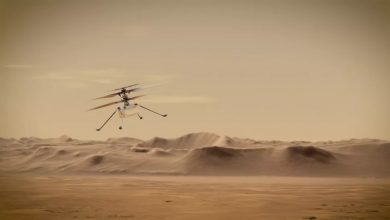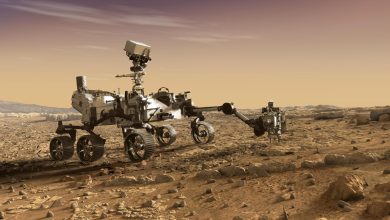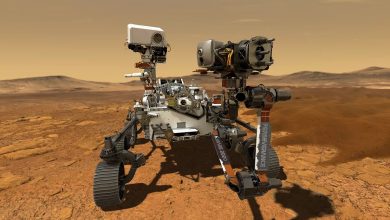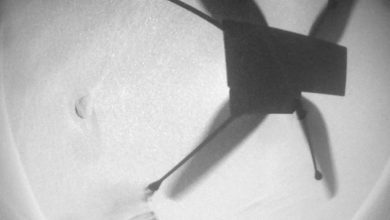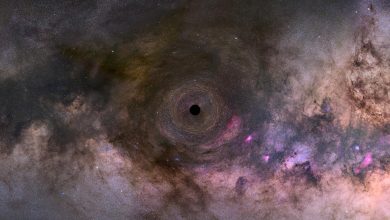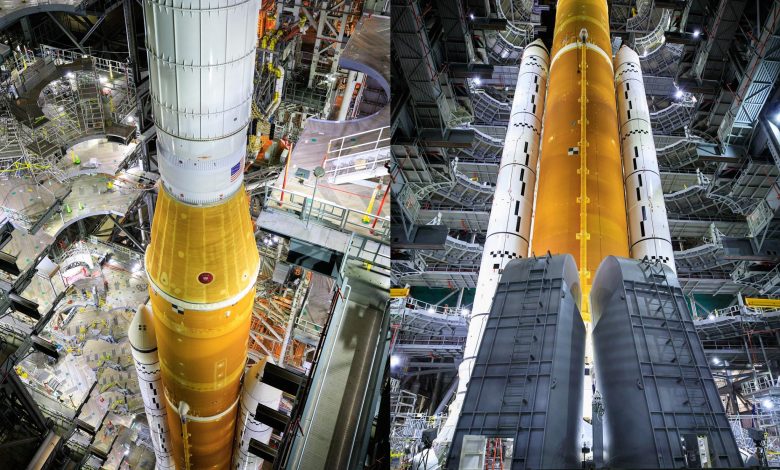
NASA’s Exploration Ground Systems (EGS) program and prime launch support contractor Jacobs are working to complete the first round of Artemis 1 pre-launch testing before the end of September. The Space Launch System (SLS) rocket for the lunar orbit mission is stacked on Mobile Launcher-1 (ML-1) in High Bay 3 of the Vehicle Assembly Building (VAB), where an Integrated Modal Test (IMT) is being completed to gather data on the natural frequencies of the SLS along with an Orion mass and center of gravity simulator.
Engineers are reviewing data on the first two of the three sets of pre-launch tests in this first round. Prior to the modal test, an Interface Verification Test (IVT) looked at the performance of the vehicle to ground interfaces, and an Umbilical Release and Retract Test (URRT) checked the ground release system for the quick disconnecting Mobile Launcher umbilicals and service arms.
After IMT is complete, EGS and Jacobs will reconnect the ground umbilicals to SLS and get ready for the Artemis 1 Orion spacecraft and CubeSats to be stacked on top of the rocket in October.
Completing the first round of integrated testing
After two months of work stacking the SLS vehicle and mating all its Mobile Launcher umbilicals and arms, EGS and Jacobs began the first round of major Integrated Test and Checkout (ITCO) testing in August. As with most of the EGS integrated operations activities in the VAB up to this point, this was the first time that the Mobile Launcher services, including power, data, environment controls, and fluids were connected to SLS flight hardware stacked on ML-1.
The Interface Verification Test (IVT) was the first of the three tests in the initial testing, which would verify that the connections from the Mobile Launcher to the rocket were working correctly.
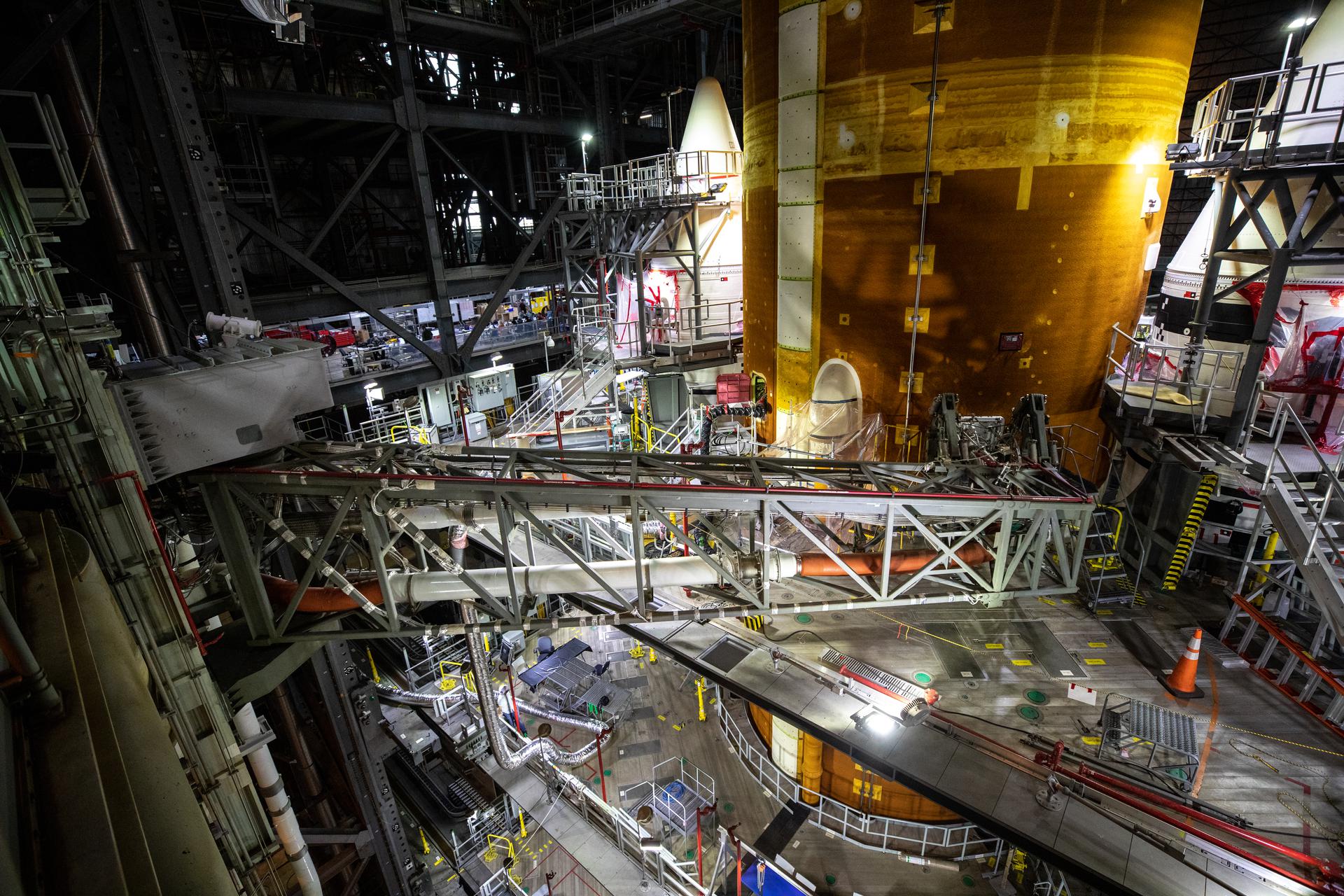
Following completion of the interface testing in late August, two “non-recurring,” special tests prior to Artemis 1 were scheduled, an Umbilical Release and Retract Test (URRT) and the IMT. With the knowledge that the umbilical and modal tests would require breaking those connections after first establishing and validating them, the Interface Verification Test was an opportunity to power up ground and flight systems and take an advanced look at how they worked together.
“We [powered] up all the [SLS] elements, Core Stage, Booster, ICPS (Interim Cryogenic Propulsion Stage), as we went through this initial portion of the Interface Verification Testing,” Dan Florez, EGS Lead NASA Test Director (NTD) for Integrated Testing, said in a September 23 interview. The first round of interface testing was completed in early September.
“Most of these tests were element-specific, so we were testing the Core Stage and Core Stage and Booster connectivity with the ground, buying down some requirements ahead of future testing, as well as the standalone ICPS testing with ground interfaces. So essentially just verifying that our ground to flight interfaces were properly functioning.”
“For this first portion of IVT we met and completed all the test requirements that were intended,” Danny Zeno, the senior NTD who oversees Integrated Test for EGS, said in the interview. “As far as the intent of the test objectives, they were all completed as per the plan.”
“Folks are still looking through the data,” Zeno added. “In the next couple of weeks as the engineers continue to analyze and go through the data, we’ll go collect all those lessons learned and have a post-test tag up with the team to see what improvements we have both from an operational and technical perspective.”
In order to validate the functionality and the integrity of the connections, several Main Propulsion System (MPS) components in both SLS stages were powered on, and the umbilical interfaces were leak-checked. Systems in both the Core Stage and ICPS were powered up, and some of their pneumatic flight bottles were brought up to high pressure or flight pressure to support the leak checks.
A hazardous gas detection system samples the atmosphere inside the rocket’s engine compartments and also at the umbilical interfaces where ground-side and flight-side plates are connected.
“We did a lot of leak checks for our pneumatic commodities for Core Stage and for ICPS,” Florez said. “We do have future testing after we remate the umbilicals to go perform essentially the same test that we performed initially with some additional tests [that are] a little bit more complex before we get into more dynamic testing.”
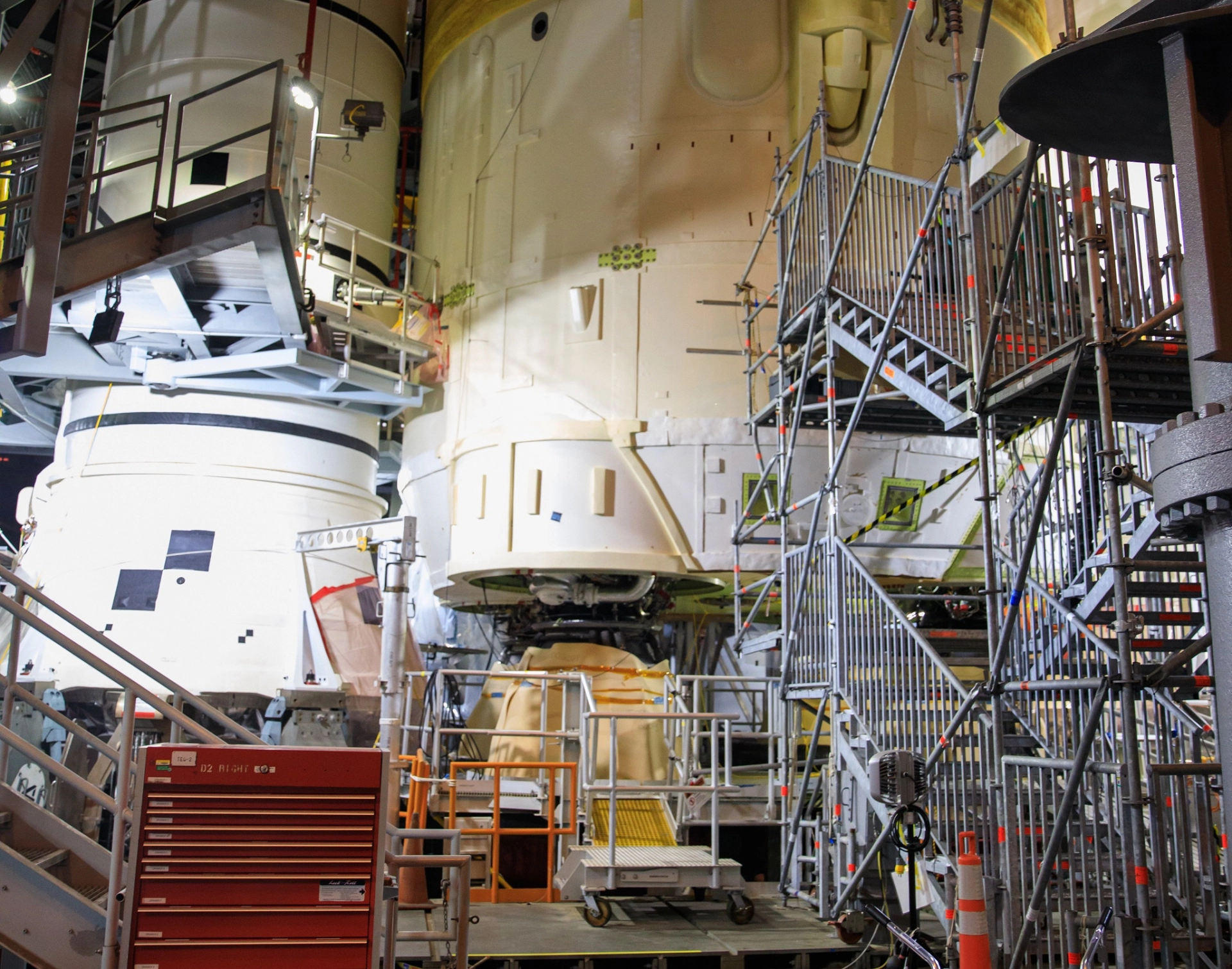
After the modal test work is completed, the SLS umbilicals will be remated. After Orion is stacked on top of the launch vehicle, the Orion umbilical will be connected to the spacecraft instead of the Orion mass simulator.
The IVT should only be necessary once in future pre-launch processing flows, but during the Artemis 1 pre-launch work a second Interface Verification Test will revalidate the umbilicals after they are mated again.
“We’re essentially going to perform the majority of the tests that we did during the first round, [to] validate that we mated the umbilicals correctly,” Florez said. “We have more dynamic tests that will require more elements to be powered up simultaneously, [but] essentially we will be performing most of the tests and leak tests that we performed during the first round of IVT.”
EGS and Jacobs are managing schedules towards when they would be ready to roll out and count down to launch, as opposed to predicting when Artemis 1 will lift off. Estimates of when the flight and ground hardware will be ready for launch count range from a working date to a “risk assessed” date.
The working date is often interpreted as a “no earlier than” date since it’s the projection of how long the work would take without necessarily considering the current situation and set of factors. Currently, projections are that early January is the soonest that preparations could be completed and EGS/TOSC would be ready.
There are also still many weeks of schedule risk given the first-time nature of the work and the remaining potential for tropical weather stoppages during the current hurricane season.
With the projection that the soonest everything could be ready to launch Artemis 1 moving into January, the SLS Program and Solid Rocket Booster (SRB) prime contractor Northrop Grumman has completed an analysis of the amount of time the SRBs can be stacked. The generic limit for the Boosters is a maximum of 12 months, but additional measurements were taken during Booster stacking operations early in 2021 and the analysis using that data says the limit can be extended another six months for the Artemis 1 Boosters.
Umbilical test helps validate coordination, timing at liftoff
In parallel with the Interface Verification Test, the SLS vehicle was being prepared inside and outside for the umbilical and modal tests that would follow. The modal tests required the SLS to be in a configuration close to its flight configuration, with sensors and wiring for test instrumentation installed and distributed across the vehicle.
The IMT also required exclusive access to the SLS, Mobile Launcher, and High Bay 3, which meant that the processing team had to completely back out of the vehicle beforehand. The modal test itself also required essentially a full disconnect from the ML, which the umbilical test provided.
As with other big tests, the test runs may last a few hours or a few seconds but are preceded by weeks of preparation work and followed by more weeks of post-test reconfiguration.
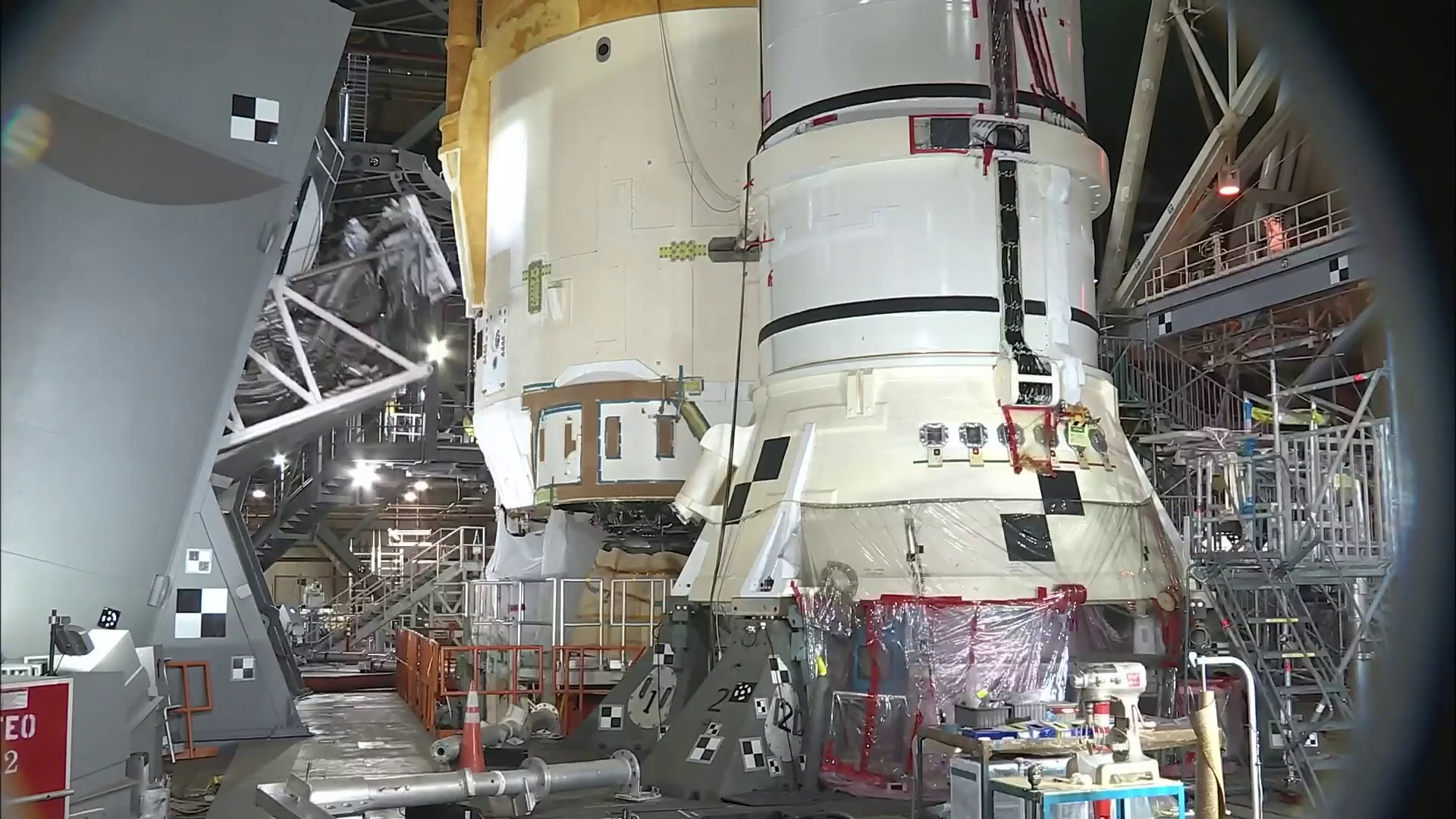
Fully closing out the vehicle for the URRT and IMT meant that ongoing work being performed in the different equipment bays inside the Core Stage and the Launch Vehicle Stage Adapter (LVSA) needed to be paused. Beginning in August and running into September, the temporary work platforms and tools installed inside the equipment bays of the vehicle were removed.
To prepare for the umbilical test, the final connections were also made from the Mobile Launcher to SLS and the Orion mass simulator temporarily stacked on top. In addition to the service arm connections to allow the vehicle to be powered up and checked out, the Vehicle Stabilizer System was attached to the forward skirt of the Core Stage and the Orion Service Module Umbilical plate and lines were connected to the Orion simulator.
The Umbilical Release and Retract Test (URRT) was conducted on the evening of September 19. It allowed EGS to test the split-second liftoff coordination between the SLS flight computers that will finish the terminal countdown and the ground’s Launch Release System.
“[The purpose of the test was] to make sure that our ground hardware is going to react as intended when it receives the signal from the vehicle,” Florez said.
The SLS flight computers will commit the vehicle to flight when they send the final, irrevocable fire commands to the two Solid Rocket Boosters’ ignition systems. Once those commands are sent, the SRBs reach full thrust almost instantaneously along with a near-simultaneous vehicle first motion. The Launch Release System needs to receive a signal from the vehicle so it can disconnect all the ground umbilical connections from the SLS and swing all the umbilical arms away as quickly as possible.
“Obviously all the dynamics happening [at liftoff] with all these umbilicals and arms moving out of the path of the rocket is a critical part of the countdown, so our engineering team put a good story together and rationale technically, especially based on the lessons learned from the Apollo timeframe of the importance of validating that prior to actual first launch attempt,” Zeno explained. “Otherwise the only time we’d really see all the arms retracting at the same time would be on launch day, which would be a significant risk.”
“In order to reduce that risk and ensure that the intent of how the arms are intended to move and be commanded is insured if you will, the test was put in place. So I’d say it’s very similar and very similar intent to why it was done in the Apollo days and obviously it’s a significant technical risk reduction test as we prepare leading up to launch.”
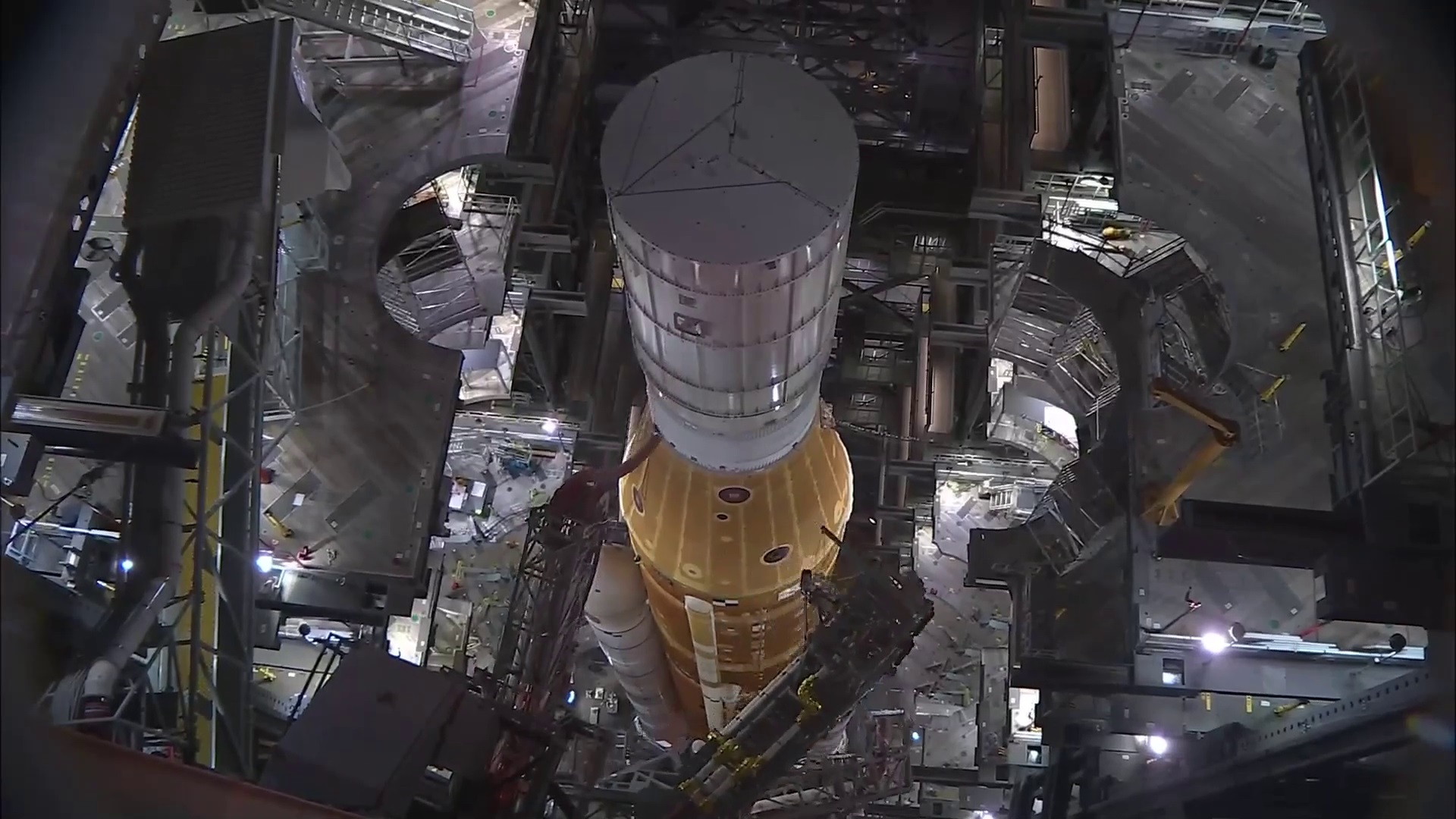
The test focused on the ground-side Mobile Launcher systems and the reaction to the liftoff signal, so the vehicle was essentially not active for the test. “We did the actual, physical release and retract with the vehicle powered down, so we’re not risking damage to any of the internal hardware, the batteries, or any of electrical components in the vehicle,” Florez explained.
Orion and SLS are operating predominantly on battery power during launch and ascent to orbit. The test cuts all the ground connections to the vehicle and would have left the SLS systems physically isolated with some power supplies that are only designed to last a few minutes beyond the eight-minute flight to orbit insertion. Instead, SLS was not powered, and emulation software was used to simulate the signal that starts the Solid Rocket Boosters and makes the urgent umbilical release and retract.
“We do use the SLS emulation so it’s essentially the same signal path that we would get from the vehicle to initiate that release; however, instead of that being initiated by the vehicle itself, it’s initiated by our GSE (Ground Support Equipment),” Florez said. “We did utilize our Ground Launch Sequencer (GLS) for this test, to make it as close to a launch countdown as possible to give us the best test and it did work out pretty well.”
“It’s a very abbreviated countdown, we count down just the last ten minutes but we don’t send the same commands that we would send for a normal launch, just the ones required for this test.”
Another integrated test of the coordination between the vehicle and ground systems will be performed later in the processing flow after Orion is stacked on top of SLS. “We’ll do a similar test downstream where we’ll actually keep the umbilicals mated and test the vehicle interfaces simulating a release, but actually keeping the umbilicals physically in place.”
For that test, the vehicle will be powered, and the test will demonstrate the command path taken from the SLS flight computers that issue the liftoff signal that fires the igniters to start the SRBs. The signal is also passed from the Booster avionics to the Mobile Launcher via umbilicals plugged into the SRB aft skirts.
“There’s a couple of umbilicals that do not retract that are connected to the booster and that command does go down from the booster through that umbilical through the GSE (Ground Support Equipment) in the Mobile Launcher to that launch release and then the signal does get distributed to all the end items that require an action at T-0,” Florez said.
The URRT tested the release and retraction of one umbilical that attaches to Orion, one that attaches to the ICPS, and five arms that attach to the Core Stage. Coincident with liftoff, the ground-side plates are disconnected mechanically from the flight-side plates on the vehicle.
“[For] most of the umbilicals, there’s a collet that has solenoids that release what are called collet fingers,” Cliff Lanham, NASA Senior Vehicle Operations manager for EGS at KSC, said in the September 23 interview. “Then there’s pneumatic cylinders or electric winches, depending on the arm, that pull wire ropes connected to the collets that initiate retraction of the plate.”
Once the plates are disconnected and initially pulled away from the vehicle, the umbilical arms are hydraulically swung back towards the Mobile Launcher tower by the ML’s Hydraulic Arms and Accessories Service Pressure (HAASP) subsystem. The Crew Access Arm allows crews to reach the Orion Crew Module, but that swing arm is retracted away from the vehicle several minutes before liftoff.
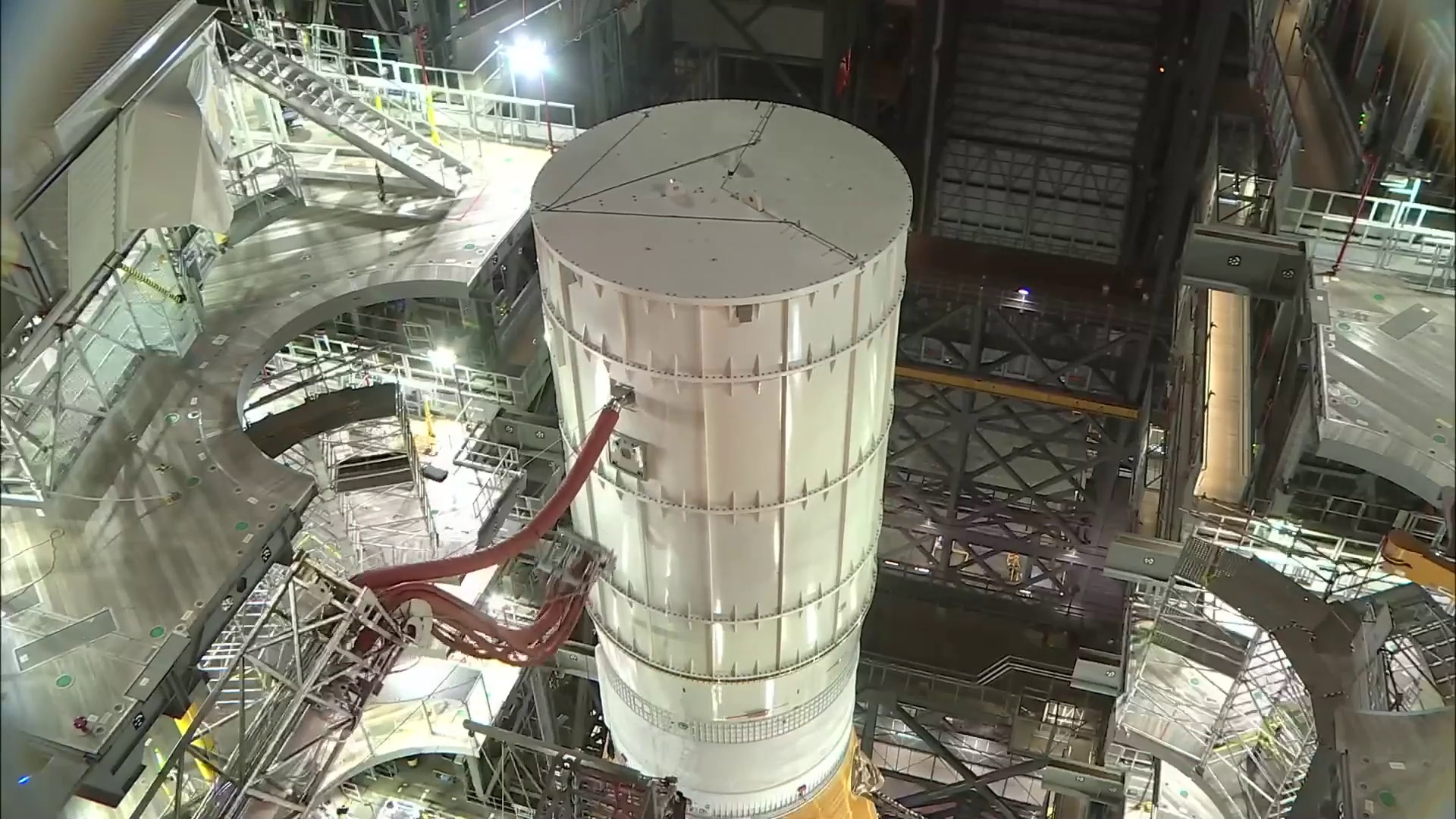
As with the first round of interface tests, engineers are still reviewing the data from the umbilical test. “They’re still looking through the data so it may be too early,” Zeno said. “At least preliminarily [it] seems like a good, successful test, but they look closer at the data and the specifics and probably frame by frame on a couple of the camera views.”
“I’m sure we’ll learn more but in general I think the test, in general, was successful.” One noticeable difference observed from standalone tests performed on each umbilical plate/arm in the LETF was with one of the attachments on the Orion Service Module Umbilical (OSMU).
The OSMU has two connections to the spacecraft: an umbilical plate that connects to Orion’s Service Module and an environmental control system (ECS) duct that provides conditioned air inside the fairing of the Launch Abort System (LAS).
For the umbilical and modal tests, the Orion mass simulator was standing in for the real spacecraft and LAS. Although primarily there to mimic the weight and center of gravity of the Orion launch stack, the simulator was equipped with connections for the OSMU services.
During the umbilical test, the OSMU umbilical plate appeared to separate and drop at the same time as the other umbilical plates connected to SLS, but the ECS/air-conditioning hose appeared to separate significantly later than in LETF tests. “They’re looking at it to determine if it was an issue,” Lanham said.
“It did appear later, but again until they look at the data it’s hard to tell. I don’t want to speculate as to what an issue may be. We might have a few minor things that we need to clean up but all in all, it appears to be a very good success.”
The release and retract systems for each of the umbilicals were tested individually at KSC’s Launch Equipment Test Facility (LETF) prior to installation on the Mobile Launcher, and a test retraction of a subset of the arms was conducted when the Mobile Launcher was out at LC-39B for the Multi-Element Verification and Validation (MEV&V) campaign in 2019, but the September 19 test was the highest-fidelity one conducted. It was the first time the release and retract systems and the ground side of the firing chain were tested as they will operate on launch day. The only exceptions were umbilicals to the SRB aft skirts that remained connected.
Preparing Orion and CubeSats for stacking
While the integrated operations team for EGS and Jacobs is completing modal testing in the VAB, the spacecraft offline operations team is preparing Orion, the Orion Stage Adapter (OSA), and a set of CubeSats for stacking. Orion is being closed out for launch in the Launch Abort System Facility (LASF).
The LAS tower assembly was stacked on top of the Orion Crew Module (CM) in late July. Although the abort motors for the Artemis 1 LAS are inert, the LAS serves as the launch fairing for the Orion Crew Module and is jettisoned a few minutes after liftoff. Following functional testing between the Orion and LAS, the four, ogive-shaped fairing panels were installed around the CM in August.
When the ogive panels are installed, the fairing structure is not yet complete. Hundreds of fasteners are then installed to secure each panel together, and then spring bumpers and tangential fittings keep the panels in place during flight.
Since the LAS fairing fully encapsulates the Orion CM, it has a hatch to allow access to the crew compartment in the launch configuration. Functional testing of the linkage between the Orion side hatch and the LAS hatch is one of the final major tasks that is being performed in parallel with final thermal protection system (TPS) closeouts. Room temperature vulcanizer (RTV) is applied over the seams between the ogive panels and the spacecraft, which also needs time to cure.
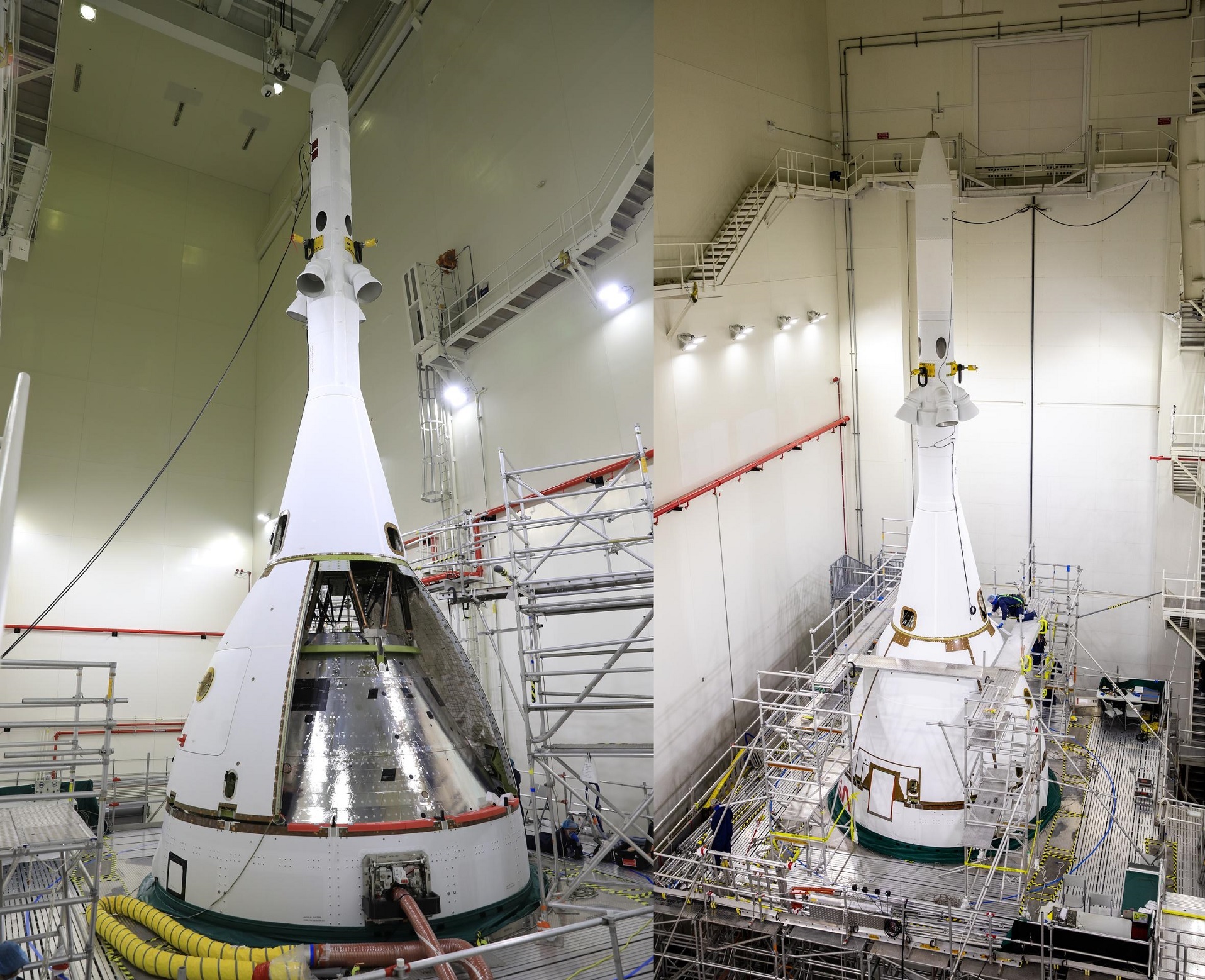
Once the hatch functionals and TPS closeout work is complete, Orion would be ready to roll to the VAB for stacking, which is currently projected for early to mid-October.
Orion will be stacked on top of the OSA flight article, which needs to be stacked first. The structural test article (STA) for the OSA was used for modal testing of the SLS and simulated Orion in the VAB, so after the Orion mass simulator is destacked, the OSA STA will be removed from the top of the ICPS.
The OSA flight article will hold almost a dozen CubeSats when it is transferred to the VAB. The STA was used for the special Artemis 1 tests in the VAB early in the processing flow to give the CubeSat teams more time to complete their pre-launch preparations and transport the spacecraft to KSC for installation.
Technical issues and COVID-related schedule impacts mean that a few of the original 13 CubeSats on the Artemis 1 manifest were not expected to make it to KSC in time to fly. After final installations and battery charging, the OSA should be ready to roll to the VAB early in October.
Road to rollout
In addition to all the other factors that play into forecasting when Artemis 1 will be ready to fly, the COVID-19 pandemic remains a major factor. After shutting down the Core Stage Green Run test campaign for two months in early 2020, the fast-spreading Delta variant infected or isolated several members of the KSC workforce in Florida during the Summer of 2021.
“As Brevard County and the surrounding area hit their peak on the variant we did experience significant numbers of folks that had to be either [quarantined] because of close contact or testing positive,” Lanham said. “And it did impact our teams because some of the teams require certain numbers of people, whether that’s a cranes, stores, and platforms type teams or some of our arms and umbilicals teams.”
“Whatever the case may be we don’t have unlimited people. So we did in fact experience some impacts and with those impacts, the team found creative ways to keep progressing forward and finding ways to make progress but all in all we did experience impacts.”
Recent work estimates forecast that the soonest that work in the VAB could be completed to enable the Artemis 1 vehicle to roll out to Pad 39B for a Wet Dress Rehearsal and other testing is early December, but continuing COVID impacts on the work is another variable of schedule risk to that forecast.
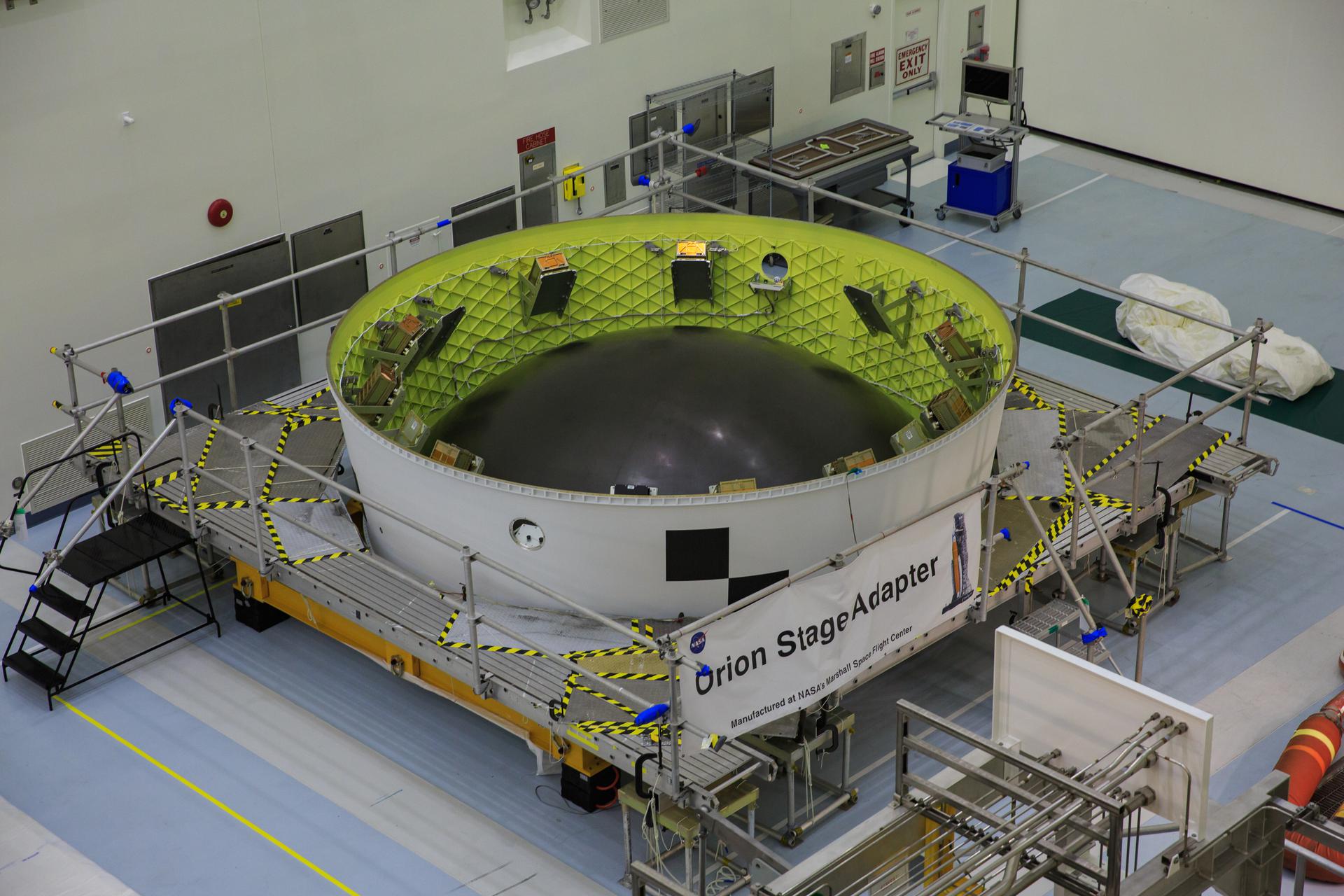
Following the URRT, the Integrated Modal Test started during the overnight shift on the evening of September 23. This modal testing is helping to characterize the natural resonant frequencies of the fully integrated SLS vehicle structure, along with the Orion mass simulator on top.
Once modal testing is complete, the requirement for exclusive access to High Bay 3, the Artemis 1 vehicle, and the Mobile Launcher goes away, and the workforce will be allowed to swarm back into the area. The remainder of the processing flow in the VAB looks more like future flows which will not have all the first-flight verification and validation test requirements.
“It’s going to be a very busy time coming out of modal and we’ll be pushing hard [going] forward,” Lanham said. Parallel work will resume post-modal test to re-establish internal work access to the SLS, remate the disconnected umbilicals, and finish stacking the vehicle after destacking the test articles.
After the umbilicals are remated and stacking is completed, the rest of the pre-rollout integrated testing will resume beginning with the second round of the IVT. More special Artemis 1 tests are planned in the VAB before rollout, including a week of Program-Specific Engineering Tests (PSET), with additional ones scheduled at the launch pad.
After internal access is re-established to the different vehicle equipment bays and the work platforms are reinstalled inside, other Artemis 1-specific work will resume in parallel with pre-launch processing and functional checkout testing. Core Stage prime contractor Boeing completed the replacement of the clutch mechanisms in all eight of the Core Stage MPS prevalves during the Summer and will be working to finish post-repair leak checks and hardware closeouts for flight.
Boeing will also install a modified hydrogen bleed line in the engine section, making the change after reviewing performance data from the two Green Run Hot-Fire tests. “Our [Core Stage] engine section work is going to be critical,” Lanham said.
“Boeing has made great progress on the clutch (remove and replace). They have done some work with the (deconfiguration) for the bleed (modification), but that will be some of the work we get into as soon as possible in the engine section, post-modal. So we do have to get that bleed mod done [and] towards the end of that flow in the engine section we’ve got a significant amount of work to do to put the engine blankets back on, so we’ll have to install those.”
LVSA prime contractor Teledyne Brown Engineering will also be doing some rework of the cabling inside the Core Stage to ICPS adapter.

